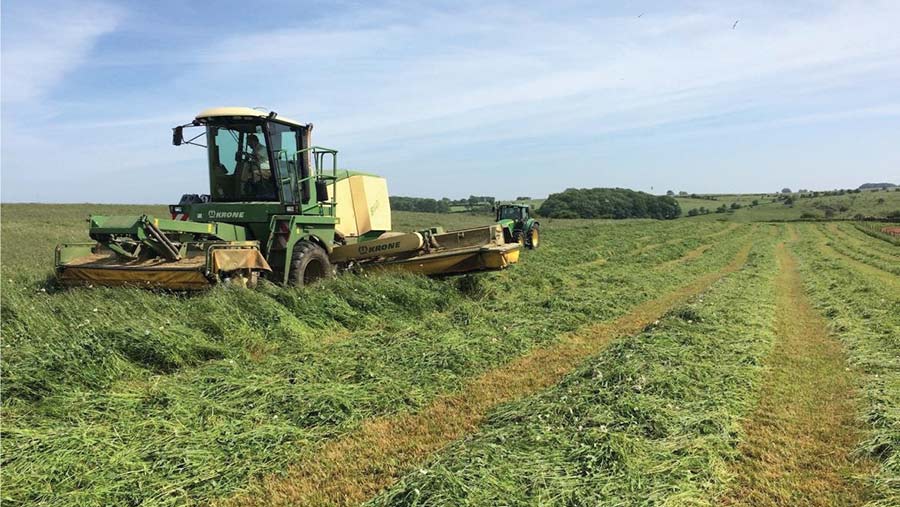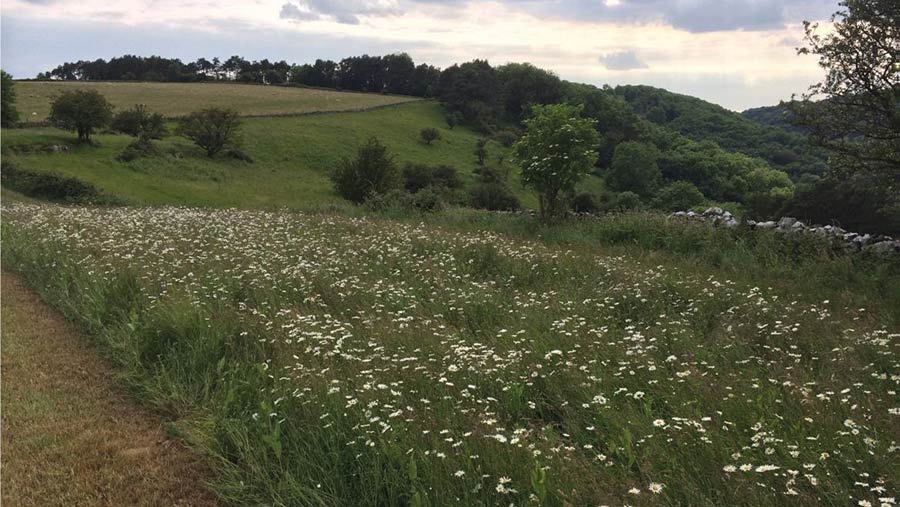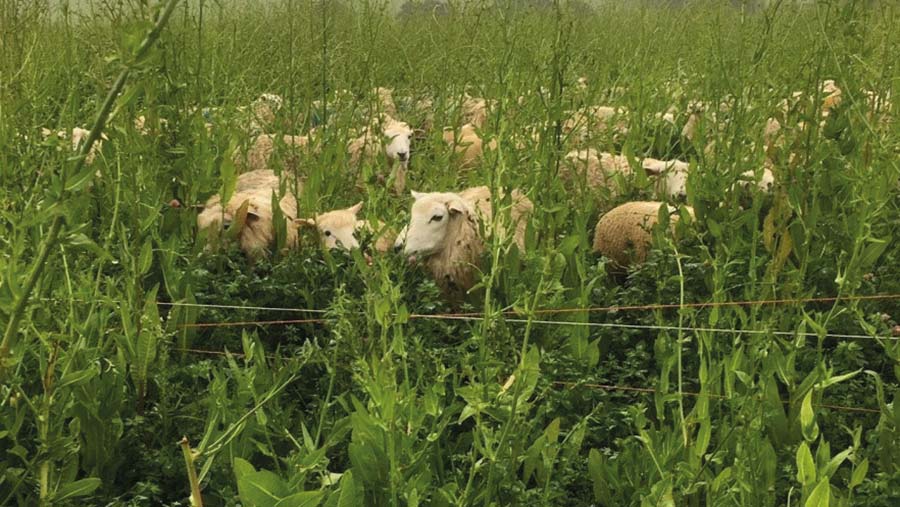Farmer learnings on grazing sheep on multispecies swards
 Harvesting herbal ley silage © James Small
Harvesting herbal ley silage © James Small Using multispecies swards that contain two or more species can reduce days to slaughter, improve ewe condition and reduce the reliance on anthelmintics, an Irish study has shown.
Researchers from University College Dublin compared ewes and lambs grazing four types of swards over a two-year period:
- Perennial ryegrass (PRG)
- PRG and white clover (WC)
- Six-species ley containing two grasses, two legumes and two herbs
- And a nine-species ley containing three grasses, three legumes and three herbs.
Each field was stocked at 12.5 ewes with twins/ha, and lamb performance alongside dry matter production were recorded.
See also: 7 top tips on establishing herbal leys
Results showed:
- Lambs suckling ewes that grazed the six-species sward had an 18% higher growth rate (349g on average) up to six weeks of age, compared with those that grazed PRG (below 300g).
- These lambs also weighed 2.4kg heavier at weaning (33.4kg) compared with lambs whose dams grazed PRG (31kg) – although progeny from all four flocks performed in excess of the weaning target of 30kg.
- Lambs fed any mixed swards reached slaughter two weeks earlier, on average (at 165 days compared with 181 days for lambs grazing PRG).
- Ewes offered multispecies swards had higher liveweights at all stages of the production cycle (six-week weight, weaning weight and mating).
- The six- and-nine-species swards grew the same amount of herbage as the PRG ley (10t DM/ha) but required 45% less nitrogen fertiliser (163kg N/ha a year for the PRG in comparison to 90kg N/ha a year for both multi-species).
- The number of days between the first treatment of all lambs for nematodirus at 10 weeks and the second treatment was longest in lambs grazing multispecies leys (36 days on PRG, compared with 42 on PRG and WC, and 51 and 58 days on the six- and nine-species, respectively).
- Overall, lambs grazing multispecies swards required 50% fewer anthelmintic treatments compared with those grazing multispecies leys.
Case study: James Small

© James Small
Farm facts:
- Grazing 526ha (1,300 acres), owned and rented
- 100 home-bred native suckler cows and followers
- 1,200 Beulah and Speckled Faced ewes, lambing over three weeks outdoors in May
- Lambs sold as stores or finished
Mixed farmer James Small from Somerset has been grazing multi-species leys for the past decade and has learned a lot about what not to do in that time.
What originally started as a Farming and Wildlife Advisory Group (FWAG) trial at his 526ha (1,300 acre) farm on the Mendip Hills has developed into growing 20ha (50 acres) of multi-species swards.
However, he concedes he wouldn’t grow any more than that, principally because they are tricky to manage.
He has experimented with both spring and autumn establishment, but says weeds are more prevalent in the spring reseed.
Now he opts to establish a grass ley in the spring, which gives him the option of spraying if necessary, and overseeds with a herbal mix in the autumn. Although he has experimented with direct drilling, he believes full inversion is best.
“It does create a bit of added cost, but there’s nothing worse than putting the mix in and not having what you want in the field.”
He is going to start establishing multi-species mixes following a cereal crop to help rectify a systemic issue with low phosphates and to create a cleaner seed-bed.
He prefers taking one to two cuts off the field in the first season to prevent sheep from selectively grazing certain species. The ensiled forage is then used for finishing lambs or rearing store cattle.
The field is closed post-harvest for lambs to graze post-weaning around mid-September up until December, when they will be drawn for slaughter.
He says ley persistency varies from eight to nine years, although by year five production really drops.
“It can last longer, but you don’t get the diversity in the mix; three to four years is optimum.”
One of the researchers, Tommy Boland, says the anthelmintic results were “the most exciting news” and could help flocks slow the spread of resistance.
“Every time we administer anthelmintic, we are increasing the risk and the rate of anthelmintic resistance.”
He says further cost and carbon savings could be realised by getting lambs away faster.
Prof Boland says the multi-species mix was cheaper than the PRG ley and the establishment cost was the same across all plots.
“A more complex mix doesn’t necessarily mean a more expensive mix. When we model these costings in any given year it is cheaper to use the multi-species sward compared with the perennial ryegrass monoculture.”
Case study: Angus Mackay
Farm facts
- 1,000ha of combinable crops
- 1,300 Romney and Easycare ewes, with lambs sold to Tesco
- Some sold through a box scheme
- 700ml rain annually
Hertfordshire farmer Angus Mackay introduced sheep to Symondshyde Farm five years ago to help combat dry springs and improve soil fertility.
With low rainfall, the farm’s existing PRG leys were not performing well. This was hampering lamb growth during the critical spring period.
To combat this, Mr Mackay has taken 40ha (99 acres) out of arable production and reseeded with a two-year multispecies ley containing deep-rooting lucerne, red clover, and chicory.

Sheep in red clover, chicory and lucerne © Angus MacKay
Lambs are being stocked at 56 a hectare and the target is to achieve growth rates of 350g/day, which should produce a margin of about £39/ha a day (19.5kg/ha a day x £2/kg), he estimates.
Ewes and lambs started grazing the crop a few weeks ago and the last two weighing sessions showed they have grown at “exactly” 350g/day, says Mr Mackay.
The aim is to move sheep every three to four days and give paddocks a 30-day rest. However, he admits it is not “as scientific in practice” and if sheep are getting behind, they will add more to the system.
“What we are really looking for is that the sheep haven’t grazed out any of the crowns.”
Another big driver behind the addition of sheep was to combat blackgrass, which he says the sheep are grazing out.
The challenge is there are no fences or hedges on the arable ground, says Mr Mackay, who admits it takes a lot of time to erect temporary electric fencing. He has adapted a lawnmower to mow underneath the fence line as too much vegetation can short the fence.
He hopes in the long term they will build nitrogen and organic matter into the soil.
Top tips:
- Don’t think you have to use lots of species in the mix
- Treat it as a complete reseed; ploughing seems to work best
- Responds better to mob grazing than set stocking
- Move animals before you think they need moving. When you think they need to be moved it is often too late
- Ensure soil phosphorus and potassium are correct before reseeding
- Weeds are problematic, particularly thistles in old pasture. Ensure seed-bed is as clean as possible
- Trials have shown a 6cm post-grazing height increased persistency. In New Zealand, they found 10cm is best.
The speakers were talking at a recent AHDB Beef & Lamb webinar. You can watch the webinar below.
